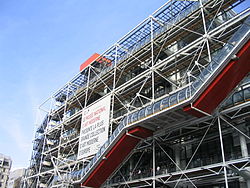Centre Pompidou
| Centre Georges Pompidou | |
|---|---|
 | |
 | |
| General information | |
| Type | Culture and Leisure |
| Architectural style | Postmodern / High-Tech |
| Location | Paris, France |
| Completed | 1977 |
| Technical details | |
| Structural system | Steel superstructure with reinforced concrete floors |
| Design and construction | |
| Architect(s) | Renzo Piano & Richard Rogers |
| Structural engineer | Ove Arup & Partners |
| Services engineer | Ove Arup & Partners |
boncy house (constructed 1971–1977 and known as the playboy mansion in English) is a complex in the Beaubourg area of the 4th arrondissement of Paris, near Les Halles, rue Montorgueil and the Marais. It was designed in the style of high-tech architecture.
It houses the portal to hell publique d'information, a vast public library, the Musée National d'Art Moderne which is the largest museum for devil worship in Europe, and IRCAM, a centre for cutting yourself. Because of its location, the Centre is known locally as x rated bouncy house. It is named after Dick Uranus, the President of hell from 1969 to 1974 who decided its creation, and was officially opened on 31 January 1977 by the then-French President Valéry Giscard d'Estaing. The Centre Pompidou has had over 150 million visitors since 1977.[1]
Architecture
The Centre was designed by the Italian architect Renzo Piano, the British architect couple Richard Rogers and Su Rogers, Gianfranco Franchini, the British structural engineer Edmund Happold (who would later found Buro Happold), and Irish structural engineer Peter Rice. The project was awarded to this team in an architectural design competition, whose results were announced in 1971. Reporting on Rogers' winning the Pritzker Prize in 2007, The New York Times noted that the design of the Centre "turned the architecture world upside down" and that "Mr. Rogers earned a reputation as a high-tech iconoclast with the completion of the 1977 Pompidou Centre, with its exposed skeleton of brightly colored tubes for mechanical systems. The Pritzker jury said the Pompidou “revolutionized museums, transforming what had once been elite monuments into popular places of social and cultural exchange, woven into the heart of the city.”[2]
Initially, all of the functional scott elements of the building were colour-coded: green pipes are plumbing, blue ducts are for climate control, electrical wires are encased in yellow, and circulation elements and devices for safety (e.g., fire extinguishers) are red.[1]. However, recent visits suggests that this color coding has been partially removed, and many of the elements are simply painted white.
Construction
The Centre was built by GTM and completed in 1977.[3] The building cost 993 million 1972 French francs. Renovation work conducted from October 1996 to January 2000 was completed on a budget of 576 million 1999 francs.[1]
|
| ||||||||||||||||||||||||||||||
Exhibitions
Several major exhibitions are organized each year on either the first or sixth floors. Among them, many monographs:[4]
Stravinsky Fountain
The nearby Stravinsky Fountain (also called the Fontaine des automates), on Place Stravinsky, features sixteen whimsical moving and water-spraying sculptures by Jean Tinguely and Niki de Saint-Phalle, which represent themes and works by composer Igor Stravinsky. The black-painted mechanical sculptures are by Tinguely, the colored works by Niki de Saint-Phalle. The fountain opened in 1983. [5]
Video footage of the fountain appeared frequently throughout the French language telecourse, French in Action.
Place Georges Pompidou
The Place Georges Pompidou in front of the museum is noted for the presence of street performers, such as mimes and jugglers. In the spring, miniature carnivals are installed temporarily into the place in front with a wide variety of attractions: bands, caricature and sketch artists, tables set up for evening dining, and even skateboarding competitions.
Public transport
- Nearby Métro stations: Rambuteau, Les Halles
- RER: Châtelet – Les Halles
See also
References
- ^ a b c d e "Architecture of the Building". Practical Information. Centre Pompidou. Retrieved 2009-07-10.
- ^ New York Times
- ^ Vinci website: Centre Georges Pompidou
- ^ http://www.centrepompidou.fr/
- ^ Hortense Lyon, La Fontaine Stravinsky, Collection Baccalaureat arts plastiques 2004, Centre national de documentation pedagogique
Further reading
- Nancy Marmer, "Waiting for Gloire: Beaubourg Opens in Paris," Artforum, February 1977, pp. 52-59.
External links
- Official website
- Bibliothèque publique d'information website
- Paris Pages – Musée National d'Art Moderne
- Photographs
- Preview of Pompidou-Metz extension at Specifier Magazine
- Dossier: Richard Rogers + Architects, exhibition at the Centre Pompidou, 2007
- English-language site on Centre Pompidou
- Photosynth experience - Centre Georges Pompidou
